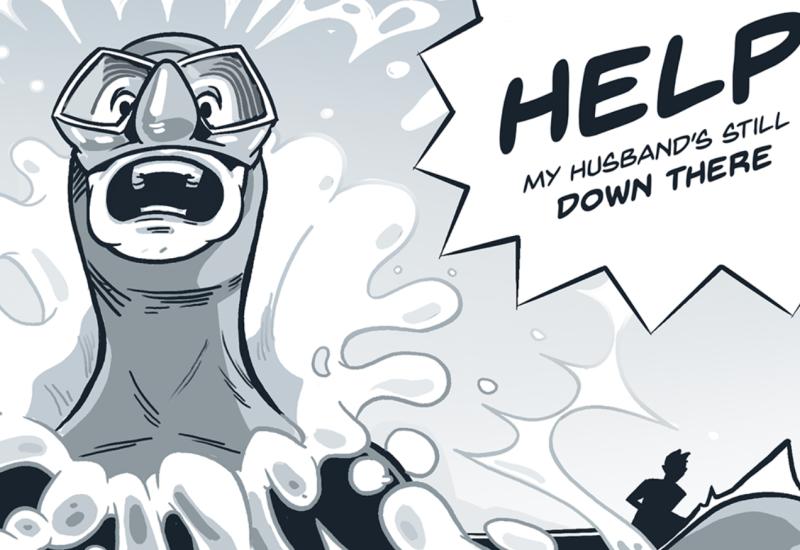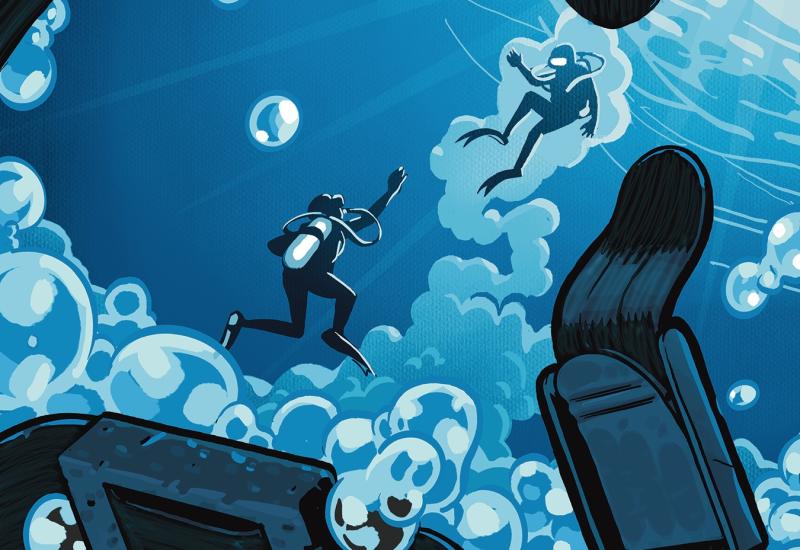The School of Hard Knocks
Rick clung tightly to the surface line, searching for his fin. Six-foot seas were tossing the dive boat like a bathtub toy, lifting the ladder clear out of the water and jerking his body so hard that his arms ached. On his first attempt to haul himself aboard, Rick had been tossed back into the water. Confused, angry at himself and tired, he looked up to see he'd been swept underneath the swim platform, which was now crashing toward his face. Rick lifted his arms to fend off the boat, then everything went black.
The Dive
Rick was an experienced recreational diver in good physical condition with numerous ocean dive trips under his belt. He and his buddy boarded the dive boat at 7:30 a.m. for a charter to a wreck in 120 feet of water. The seas were only one to two feet as the boat made its way to the wreck. The captain gave a detailed dive briefing, including special instructions on reboarding the boat if the seas were to pick up during the dive. Rick listened intently, but noted some of the captain's procedures were different from the ones prescribed by his training. After considering the differences for a moment, he decided to keep his questions to himself.
At the end of the dive, Rick and his buddy were well within no-decompression limits when they ascended to 15 feet and completed a very bumpy safety stop. While hanging on the anchor line, Rick looked toward the surface. He could tell from the violent motion of the surface water crashing against the boat's hull that the surface conditions had worsened.
The buddies then ascended behind the pitching boat within reach of the trailing safety line. Rick's buddy boarded first, following the captain's instructions. While gripping the line firmly, he removed his fins, slipping the straps onto his wrists. Keeping his mask and regulator in place, he deflated his BC and timed the boat's movement in the water. When the time was right, he pulled himself toward the ladder, grabbing it as the boat approached the bottom of a trough between swells. He kept his mask and regulator in place and climbed one or two rungs up the ladder each time the boat paused at the top of the swell or the bottom of a trough.
Meanwhile, Rick worried that if he removed his fins before grabbing the ladder he would have little control in the water. He decided that his training had kept him safe this long and that he would board the boat the way he always had. Keeping all of his gear in place, Rick used the line to pull himself close to the boat. When the stern bottomed out in a trough, he grabbed the ladder and began to remove his fins.
The Accident
Each time Rick tried to remove his fin, the force of the water nearly ripped him from the ladder. As the boat platform submerged between swells, the force of his fully inflated BC worked to keep him afloat even as the ladder tried to pull him under. Caught in a tug-of-war between his BC and the submerged ladder, it was all Rick could do to hold on. He finally got his left fin off, only to have it ripped away. He reached down to catch the drifting fin, but the boat surged upward, causing him to lose his grip and fall into the water. Rick grabbed the line and looked up just in time to see the platform come crashing down.
The nearly 50 pounds of lift in Rick's inflated BC effectively trapped him between the surface and 15 tons of falling fiberglass. The bottom of the platform struck his head, knocking him out cold.
The Rescue
Ed, the boat's divemaster, grabbed a safety line and jumped into the water. He rotated Rick's body to prevent drowning and dragged the limp diver back to the boat. Rick sustained a mild concussion and suffered a hairline fracture in his right wrist and two broken ribs.
Analysis
Rick made several errors leading to this accident. The most egregious was ignoring the advice of the experienced boat captain. Rick chose instead to follow an exit procedure that was inappropriate for the rough conditions. In six-foot seas, the stern of a boat can move vertically as much as 12 feet as it rides each swell.
Had he at least emptied his BC as he approached the boat, Rick would have been able to push off the boat and simply submerge as it crashed down on top of him. The 40 to 50 pounds of upward force from his BC trapped Rick beneath the falling boat and the surface. Only the response of a fast-acting crew prevented him from drowning.
Lessons for Life
-
Conditions can change dramatically even during a relatively short dive.
-
Follow the procedures outlined by an experienced and qualified dive crew.
-
When approaching a boarding ladder in very rough seas, keep your regulator and mask securely in place. Deflate your BC as you approach the boat so that you can easily push away from the vessel if necessary.
-
If a trail line is available on the surface, remove your fins a few feet from the boat so that you can climb the ladder immediately after reaching it.
-
Keep your fins on your wrist so you can put them back on if you're thrown from the ladder and need to swim back to the boat.
-
Always surface with enough air to allow you to breathe through your regulator all the way back on board the boat.
Rick clung tightly to the surface line, searching for his fin. Six-foot seas were tossing the dive boat like a bathtub toy, lifting the ladder clear out of the water and jerking his body so hard that his arms ached. On his first attempt to haul himself aboard, Rick had been tossed back into the water. Confused, angry at himself and tired, he looked up to see he'd been swept underneath the swim platform, which was now crashing toward his face. Rick lifted his arms to fend off the boat, then everything went black.
The Dive
Rick was an experienced recreational diver in good physical condition with numerous ocean dive trips under his belt. He and his buddy boarded the dive boat at 7:30 a.m. for a charter to a wreck in 120 feet of water. The seas were only one to two feet as the boat made its way to the wreck. The captain gave a detailed dive briefing, including special instructions on reboarding the boat if the seas were to pick up during the dive. Rick listened intently, but noted some of the captain's procedures were different from the ones prescribed by his training. After considering the differences for a moment, he decided to keep his questions to himself.
At the end of the dive, Rick and his buddy were well within no-decompression limits when they ascended to 15 feet and completed a very bumpy safety stop. While hanging on the anchor line, Rick looked toward the surface. He could tell from the violent motion of the surface water crashing against the boat's hull that the surface conditions had worsened.
The buddies then ascended behind the pitching boat within reach of the trailing safety line. Rick's buddy boarded first, following the captain's instructions. While gripping the line firmly, he removed his fins, slipping the straps onto his wrists. Keeping his mask and regulator in place, he deflated his BC and timed the boat's movement in the water. When the time was right, he pulled himself toward the ladder, grabbing it as the boat approached the bottom of a trough between swells. He kept his mask and regulator in place and climbed one or two rungs up the ladder each time the boat paused at the top of the swell or the bottom of a trough.
Meanwhile, Rick worried that if he removed his fins before grabbing the ladder he would have little control in the water. He decided that his training had kept him safe this long and that he would board the boat the way he always had. Keeping all of his gear in place, Rick used the line to pull himself close to the boat. When the stern bottomed out in a trough, he grabbed the ladder and began to remove his fins.
The Accident
Each time Rick tried to remove his fin, the force of the water nearly ripped him from the ladder. As the boat platform submerged between swells, the force of his fully inflated BC worked to keep him afloat even as the ladder tried to pull him under. Caught in a tug-of-war between his BC and the submerged ladder, it was all Rick could do to hold on. He finally got his left fin off, only to have it ripped away. He reached down to catch the drifting fin, but the boat surged upward, causing him to lose his grip and fall into the water. Rick grabbed the line and looked up just in time to see the platform come crashing down.
The nearly 50 pounds of lift in Rick's inflated BC effectively trapped him between the surface and 15 tons of falling fiberglass. The bottom of the platform struck his head, knocking him out cold.
The Rescue
Ed, the boat's divemaster, grabbed a safety line and jumped into the water. He rotated Rick's body to prevent drowning and dragged the limp diver back to the boat. Rick sustained a mild concussion and suffered a hairline fracture in his right wrist and two broken ribs.
Analysis
Rick made several errors leading to this accident. The most egregious was ignoring the advice of the experienced boat captain. Rick chose instead to follow an exit procedure that was inappropriate for the rough conditions. In six-foot seas, the stern of a boat can move vertically as much as 12 feet as it rides each swell.
Had he at least emptied his BC as he approached the boat, Rick would have been able to push off the boat and simply submerge as it crashed down on top of him. The 40 to 50 pounds of upward force from his BC trapped Rick beneath the falling boat and the surface. Only the response of a fast-acting crew prevented him from drowning.
Lessons for Life
Conditions can change dramatically even during a relatively short dive.
Follow the procedures outlined by an experienced and qualified dive crew.
When approaching a boarding ladder in very rough seas, keep your regulator and mask securely in place. Deflate your BC as you approach the boat so that you can easily push away from the vessel if necessary.
If a trail line is available on the surface, remove your fins a few feet from the boat so that you can climb the ladder immediately after reaching it.
Keep your fins on your wrist so you can put them back on if you're thrown from the ladder and need to swim back to the boat.
Always surface with enough air to allow you to breathe through your regulator all the way back on board the boat.










